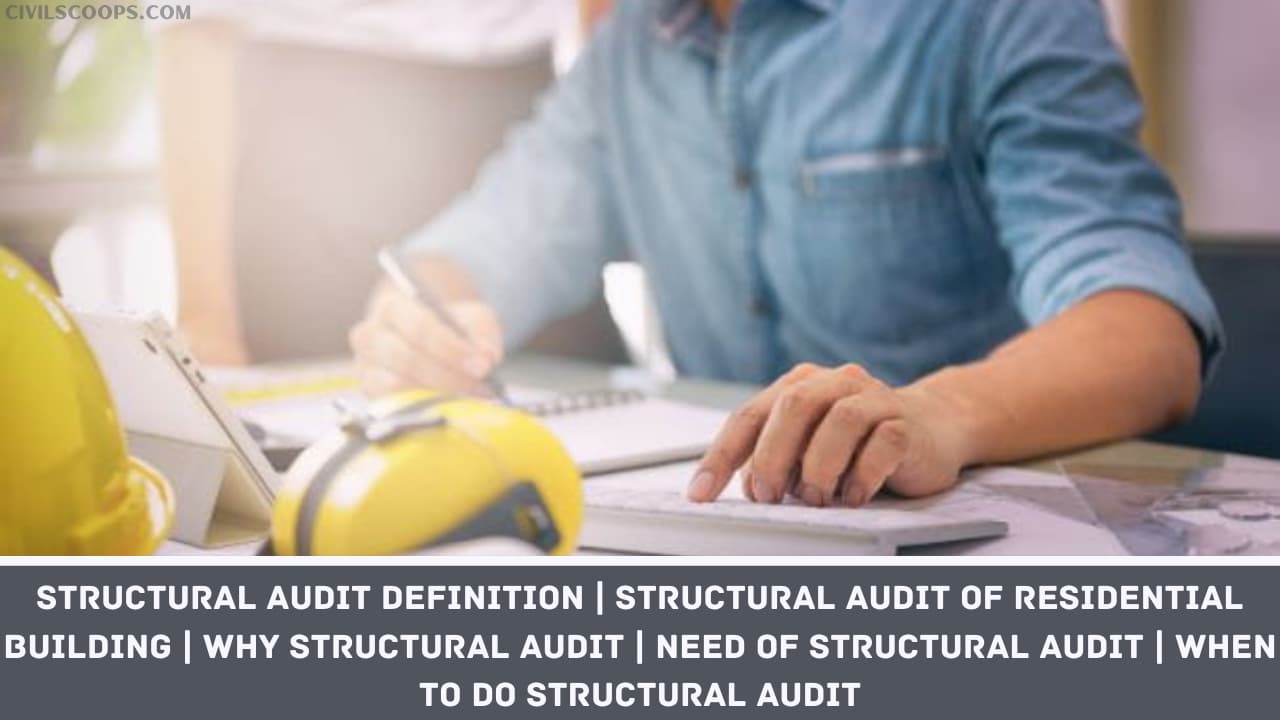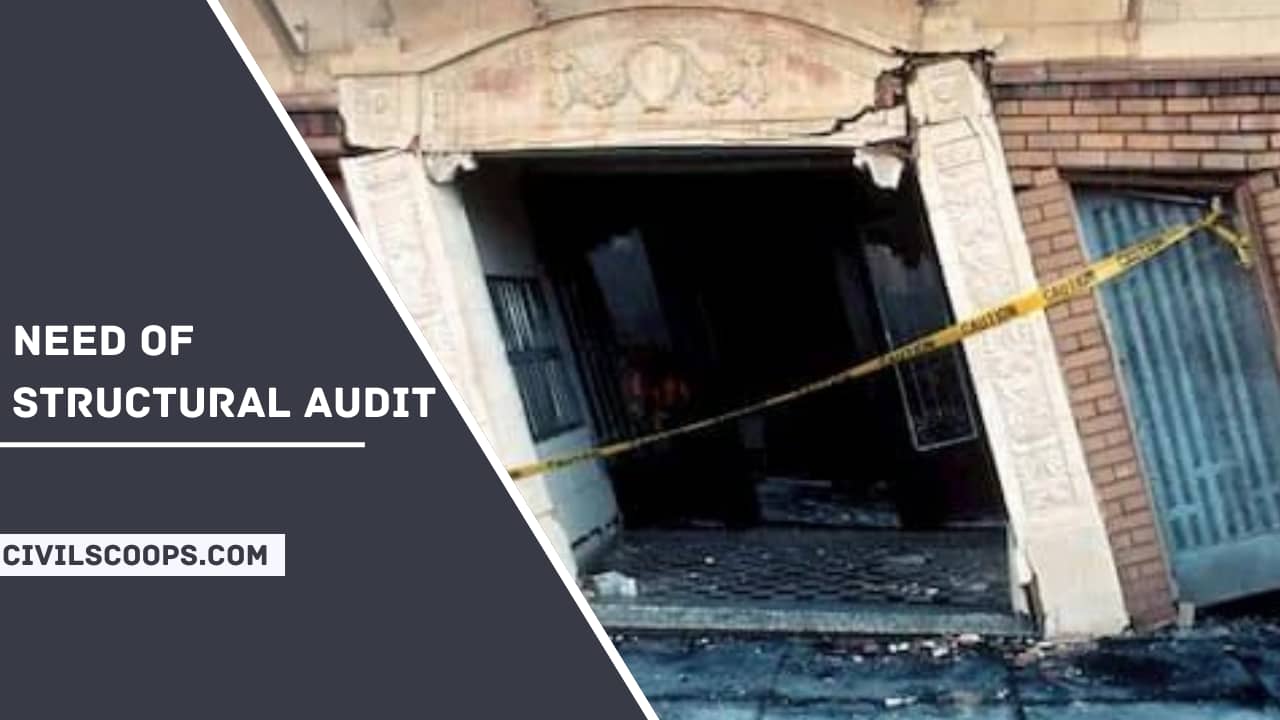Structural Audit Definition | Structural Audit of Residential Building | Why Structural Audit | Need of Structural Audit | When to do Structural Audit

Table of Contents
Structural Audit Definition
Structural Audit can be defined as a very important approach to understanding the distress level or condition of any existing civil engineering structure or a building.
The initially specialized technique used to inspect a building or a civil engineering structure to evaluate its general health is known as Structural Audit.
Doing a Structural Audit of a building can save us from disastrous consequences such as poor structural integrity of a building and insufficient fire safety of a civil engineering structure.
Structural Audit can ensure that the industrial and commercial buildings are safe as per the relevant codes and prevent any danger from befalling to the life and health of the residents and employees of the Structural Audited buildings.
As doctors examine a patient in order to understand its health condition, Structural Audit is done on a building in order to know it’s an overall health condition and performance check of a civil engineering structure.
From the reports we get by doing a structural audit of a building, we can analyse the problems and condition of that building and suggests appropriate repairs in order for the building to perform better in its service life.
Structural Audit of Residential Building

Any residential building whose life has exceeded the age of 30 years Structural Audit is done on that building. Structural Audit of a residential building is needed in order for maintenance and repairs of an existing residential building for prolonging its life.
Structural Audit of a residential building should highlight all critically damaged areas of that building and recommend immediate repair and preventive measures. Structural Audit of a residential building should investigate the poor structural integrity of the existing frames and find the defects
and critical elements of different types of loadings.
Structural Audit of a residential building can help provide a strong residential building structure with cost-effective solutions for repairing damaged parts and appropriate maintenance program for increasing the longevity of the residential building.
Structural Audit of a residential building will implement timely repair work which leads to prolonged life of the building, which will give safety to the residents living in that building.
In India, there are many old residential buildings which are losing strength due course of time. In order to prevent them from falling down the Structural Audit of those residential building should be done.
Why Structural Audit?
Structural Audit is done in a building in order to verify the load conditions of that civil engineering structure. Structural Audit is done in a building in order to evaluate the structural system like frame structure of a building.
Structural Audit is done in a building in order to find defects in the structure, damage to the building surface, deformation of the frame structure. Structural Audit is done in a building in order to check the plan and alignment of that building.
Structural Audit is done in a building in order to assess the maintenance cost due to exposure to an aggressive environment. Structural Audit is done in a building in order to check the fire safety issue of that building.
Structural Audit is done in a building in order to check the electrical wiring safety of that building. Structural Audit is done in a building in order to ensure safe working facilities and prevent loss of life or injury of the employers. Structural Audit is done in a building in order to comply with the structural requirements as per the relevant codes.
Structural Audit is done in a building in order to prevent interruption of the supply chain by gaining accurate knowledge of the safety of the supply chain.
Need of Structural Audit

- Structural Audit is needed to recognize and identify the different types of structural defects that may occur in a civil engineering structure.
- Structural Audit is needed to identify any signs of material deterioration due to extreme weather conditions or ravages of time.
- Structural Audit is needed to find any signs of structural distress and deformation of the civil engineering structure due to unequal distribution of load.
- Structural Audit is needed to identify problems that may occur due to alteration and addition of materials or parts in the structure. If a structural audit is not done while modification, it may result in overloading, and finally, the building will collapse due to its own weight.
When to do Structural Audit?
Structural Audit is done according to the model bye-law no. 77 for co-operative housing societies. A structural audit is mandatory for any residential building if the age of that building is between15 to 30 years.
A structural audit must be carried out at an interval of five years if the building is between 15 to 30 years old. If a building is older than 30 years, a structural audit should be carried out once in three years.
Structural Audit is also done when cracks are visible on the frame structure or surface of the newly constructed building. Defects may have occurred while construction of the building or uneven load distribution to the pillars may cause the building to collapse. This can be prevented by doing a structural audit of that building.
[su_box title=”FAQ” style=”default” box_color=”#333333″ title_color=”#FFFFFF” radius=”3″ class=”” id=””]
Structure Audit Definition
Structural Audit is an overall health and performance checkup of a building like a doctor examines a patient. It ensures that the building and its premises are safe and have no risk. It analyses and suggests appropriate repairs and retrofitting measures required for the buildings to perform better in its service life.
When to Do Structural Audit?
It is advisable to carry out a structural audit of any building at least once in five years; and for buildings ageing more than 30 years, a structural audit should be carried once in 3 years.
Structural Audit Report
A structural audit report is presented to the society by the consultant which entails the following: Recommendations for repairs based on the assessment of deterioration, breakage, and faulty materials. Retrofitting, and restoration measures to bring the damaged components up to the required standard.
Structural Audit Bye-Laws
The model building bye-laws 2016 states that a structural audit is compulsory. It mentions that in a building aged 15 to 30 years, the audit has to be conducted once in five years, while those older than 30 years need an audit every three years.
Structural Audit Methodology
A methodology for Structural Audit was first presented by the Indian Society of Structural Engineers. “Structural audit is the inspection or examination of the building, to evaluate the strength so as to improve its appropriateness, safety, efficiency”.
[/su_box]
[su_note note_color=”#F2F2F2 ” text_color=”#333333″ radius=”3″ class=”” id=””]
Like this post? Share it with your friends!
Suggested Read –
- Core Cutter Method | What is Compaction of Soil
- What Is Plaster | Plaster Ratio | History of Plastering | Requirements of Good Plaster
- What Is Drip Irrigation | Drip Irrigation Advantages | Types of Irrigation | Drip Irrigation System
- Tests on Stones | Crushing Strength Test, Water Absorption Test, Abrasion Test, Impact Test, Acid Test
- What Is Self Compact Concrete | What Is Slump Flow Test | Equipment for Slump Flow Test | Procedure of Slump Flow Test
[/su_note]
Originally posted 2022-07-16 17:44:59.
